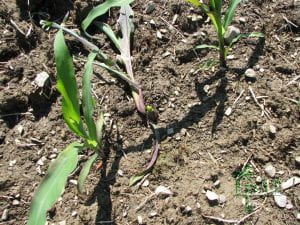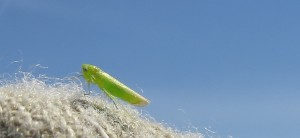Contents
Cornell Small Grains Management Field Day at Poorman Farms in Seneca Falls on June 2.
You are invited to attend the Cornell Small Grains Management Field Day at Poorman Farms in Seneca Falls on June 2. Visit our website to view the agenda and pre-register (free)!
Alfalfa Weevil
Much of the alfalfa weevil issues across the state have been controlled with the first harvest of alfalfa. It does not mean to stop scouting for alfalfa weevils. This pest can be an issue in regrowth. The degree-day model for alfalfa weevil indicates we are at 1st to 3rd instar larvae. The warmer weather, coming this week will aid in the development of the weevil to the pupa stage more quickly. Once in the pupa stage, the weevil is done feeding for the season.
Alfalfa Weevil Pupa (Cocoon)
For more on alfalfa weevil please view the link to management information:
https://cals.cornell.edu/field-crops/forages/insects-forage-crops/alfalfa-weevil
Alfalfa Weevil Degree Day Accumulations from March 1 to May 29
| Weather Station Location | Alfalfa Weevil | Life Stage |
| Arkport | 372 |
Larvae Feeding 1st instar |
| Bergan | 429 |
Larvae Feeding 2nd instar |
| Ceres | 354 |
Larvae Feeding 1st instar |
| Conesus Lake | 461 |
Larvae Feeding 2nd instar |
| Corwin | 396 |
Larvae Feeding 2nd instar |
| Farmington | 439 |
Larvae Feeding 2nd instar |
| Gansevoort | 492 |
Larvae Feeding 3rd instar |
| Geneva | 450 |
Larvae Feeding 2nd instar |
| Highland | 543 |
Larvae Feeding 3rd instar |
| Ithaca | 480 |
Larvae Feeding 3rd instar |
| Kinderhook | 475 |
Larvae Feeding 3rd instar |
| Lafayette | 466 |
Larvae Feeding 2nd instar |
| Laurens | 343 |
Larvae Feeding 2nd instar |
| Malone | 300 | Egg hatching |
| Northport | 542 |
Larvae Feeding 3rd instar |
| Peru | 330 |
Larvae Feeding 1st instar |
| Red Hook | 496 |
Larvae Feeding 3rd instar |
| Sherburne | 341 |
Larvae Feeding 1st instar |
| Versailles | 462 |
Larvae Feeding 2rd instar |
| Watertown | 355 |
Larvae Feeding 3rd instar |
Alfalfa Weevil Life Stage Development
Growing Degree Days for peak (50%) occurrence of stage
| Stage of Life Cycle | Degree Days * |
| eggs hatch | 280 |
| Instar 1 | 315 |
| Instar 2 | 395 |
| Instar 3 | 470 |
| Instar 4 | 550 |
| Cocooning | 600 |
| Pupa | 725 |
| Adult Emergence | 815 |
*48 degrees F base temperature
Fusarium head blight commentary, May 26, 2022:
Gary Bergstrom, Professor, Plant Pathology and Plant-Microbe Biology, Cornell University
The next several days are a critical fungicide spray decision time for winter wheat in New York. The majority of fields will initiate flowering during the early to middle portion of next week. The DMI (FRAC Group 3) containing fungicides Caramba, Prosaro, or Miravis Ace (latter includes a FRAC Group 7 fungicide) are the most effective fungicides for suppression of Fusarium head blight (FHB) and deoxynivalenol (DON) mycotoxin contamination when applied at flowering (emergence of yellow anthers on heads). A flowering application of these fungicide products should be based on FHB risk as well as the risks of powdery mildew, rusts, and fungal leaf blotches in the upper canopy based on scouting of individual fields. There is an application window of approximately 7 days from the beginning of flowering in which reasonable FHB and DON suppression can be expected. Though the calculated risk of FHB infection has previously remained low, the risk level is expected to increase with widespread rain over the next few days. Check the Fusarium Risk Assessment Tool (http://www.wheatscab.psu.edu/ ) and your local weather forecast frequently as your winter wheat crop approaches flowering. Most winter barley in New York is past growth stages when fungicide application should be considered.
Black cutworm and True Armyworm
There have been more intense catches for black cutworms with our field corn pheromone-trapping network in western and northern NY. You will likely start seeing cut plants if fields had an early infestation. It is best to start monitoring for black cutworm. We have not yet caught many armyworms, but it is a good idea to continue to scout for them. For management information, please view the following web pages.
Black Cutworm
https://cals.cornell.edu/field-crops/corn/insects-corn/cutworms
True Armyworm
https://cals.cornell.edu/field-crops/corn/insects-corn/armyworms
Interactive Map for Moth Capture of Black Cutworm and True Armyworm
Black Cutworm Degree Day Accumulations by Location
| *Location for Intense Catches |
Black Cutworm (Base 50) |
Life Stage |
|
Seneca Falls Seneca County April 26 25 Moths Caught |
391 |
Cutting Corn Plants 4th Instar |
|
Avon Livingston County May 12 23 Moths Caught |
244 |
Leaf Feeding 1st-3rd Instar |
|
Rush Monroe County May 15 39 Moths Caught |
274 |
Leaf Feeding 1st-3rd Instar |
|
Hounsfield Jefferson County May 16 25 Moths Caught |
188 |
Leaf Feeding 1st-3rd Instar |
|
Casterland Lewis County May 16 23 Moths Caught |
146 |
Leaf Feeding 1st-3rd Instar |
|
Canton St Lawrence May 16 37 Moths Caught |
140 |
Leaf Feeding 1st-3rd Instar |
|
Seneca Falls Seneca County May 22 23 Moths Caught |
167 |
Leaf Feeding 1st-3rd Instar |
|
Munnsville Madison County May 29 27 Months Caught |
0 |
Laying Eggs |
|
Housnfield Jefferson County May 22 25 Moths Caught |
96 |
Leaf Feeding 1st-3rd Instar |
|
Martinsburg Lewis County May 22 23 Moths Caught |
96 |
Leaf Feeding 1st-3rd Instar |
|
Farmington Ontario County May 29 23 Moths Caught |
0 | Laying Eggs |
|
Martinsburg Lewis County May 29 19 Moths Caught |
0 | Laying Eggs |
|
Oxford Chenango County May 29 15 Moths Caught |
0 | Laying Eggs |
*Intense Catch is over 15 moths in a week.
True Armyworm Degree Day Accumulations by Location
| *Location for Intense Catches |
True Armyworm (Base 50) |
Life Stage |
|
Seneca Falls Seneca County May 1 29 Moths Caught |
291 | Leaf Feeding |
*Intense Catch is over 15 moths in a week.
Potato Leafhopper in Alfalfa
Potato Leafhopper (PLH) has been found in the state. PLH does not overwinter in NYS and travels on storms from the south about this time of the season. Because of recent storms, we most likely have received more of them. It is best to get out and start scouting for PLH in alfalfa.
For more information, please view the following webpage:
https://cals.cornell.edu/field-crops/forages/insects-forage-crops/potato-leafhopper




